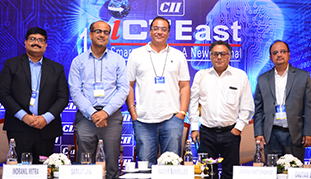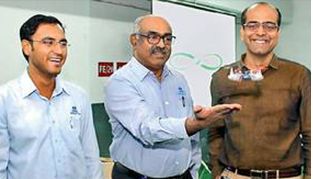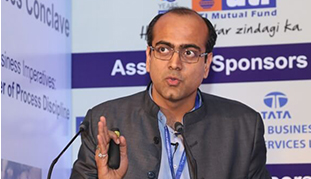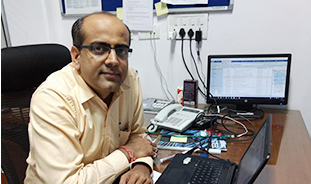

Q. One of the areas you are passionate about is ‘narrative dominance’. At a time when media has been democratized, how can a communicator with a counter-narrative get his point of view heard? What are the options, say, for a start-up/smaller player taking on a deep-pocketed established player to steer the narrative in a different direction?
 The basics of marketing don’t change – you need to have content and substance, which is led by a purpose; you need to have something which is meaningful; you need to have a set of people with whom that message resonates. Then, you need to find an efficient way of reaching them. That efficient way today could be social media platforms such as WhatsApp, Facebook, YouTube, Snapchat or Vines. That’s just a way. But the fact remains that, having a purpose and then finding an engaging, exciting way to communicate that purpose, continues to be of utmost importance. In fact, it has never been easier for messages to get picked up, because if the message resonates with people and has been put in an exciting manner, you can convert everybody on social media into your merchandisers, copywriters and bloggers. Of course, the risk that comes with it, is that of ‘post-truth’ – a thing becomes true because nobody goes and tries to verify the veracity, and when many people are saying the same thing, Google also picks it up and shows it very early on, whereas facts could get buried under the sea of data and noises.
The basics of marketing don’t change – you need to have content and substance, which is led by a purpose; you need to have something which is meaningful; you need to have a set of people with whom that message resonates. Then, you need to find an efficient way of reaching them. That efficient way today could be social media platforms such as WhatsApp, Facebook, YouTube, Snapchat or Vines. That’s just a way. But the fact remains that, having a purpose and then finding an engaging, exciting way to communicate that purpose, continues to be of utmost importance. In fact, it has never been easier for messages to get picked up, because if the message resonates with people and has been put in an exciting manner, you can convert everybody on social media into your merchandisers, copywriters and bloggers. Of course, the risk that comes with it, is that of ‘post-truth’ – a thing becomes true because nobody goes and tries to verify the veracity, and when many people are saying the same thing, Google also picks it up and shows it very early on, whereas facts could get buried under the sea of data and noises.
Q. In the duopoly that Facebook and Google enjoy, the focus is more on pace (speed of sending information out) rather than accuracy; over time, do you see there being greater public pressure on Facebook and Google to show up only what is accurate?
I think it’s already there. I see privacy norms tightening. The GDPR (General Data Protection Regulation) has already come out in Europe. I see more regulation coming up. A lot of people will start moving to other sources of information – Wikipedia, Quora, LinkedIn, Glassdoor. Interest-based fragmentation would happen. We can already see that. WhatsApp has a 256-users-per-group restriction; a lot of people are moving to Telegram now. In China, you have Baidu, Alibaba & Tencent. In Russia, you have VKontakte & Yandex. There are different ways in which fragmentation will happen. But, it will still be a duopoly or oligopoly of some nature. Media has always been that way because of its network effects. It’s now that the power is moving away from the old media to the new media.
I don’t see some of the things changing very drastically, but there is still space for you to grow if you are purposeful. Look at how Amul does it. Amul is a purpose-driven brand, and there are 20-30 hoardings across the country which are doing their marketing. Because they have a larger purpose – to protect the dairy farmers of their area of operations – and they have cute, guerilla marketing, they get by with a lot less advertising than many other players.
Q. The current pace of change is clearly the fastest the world of business has seen. Added to this, the number of uncontrollable variables seem to have multiplied. How can organizations manage the process of change better in a disruptive environment? What are the five things they should focus on?
 There is no cookie-cutter. If the answer was as simple as “Let’s do these five things and we will be safe”, there wouldn’t be such drastic churn in the Global Fortune 500 list each decade. Most of those Fortune 500 companies have very large access to resources; they have a lot of smart people that they can call on for support. Despite that, business failure does happen.
There is no cookie-cutter. If the answer was as simple as “Let’s do these five things and we will be safe”, there wouldn’t be such drastic churn in the Global Fortune 500 list each decade. Most of those Fortune 500 companies have very large access to resources; they have a lot of smart people that they can call on for support. Despite that, business failure does happen.
But I think the basics are clear:
Q. A trend that’s picking up steam is ‘reverse mentoring’. This clearly stems from the realization that the process of change that got kicked off over the last 5-7 years is irreversible. How easy or tough is it for a large organization to implement an extensive reverse mentoring initiative?
First and foremost, in any organization you must have leadership sponsorship. BCG has a nice framework called ‘DICE’ that can help focus better on any program:
This leads to a score.
But, two factors are over-weighted in ‘DICE’ – one is the integrity of the team (‘I’) and the other is the commitment of the leadership (‘C1’). The first thing we did was get commitment of the leadership. Then, for the integrity of the team, we selected people well – we advertised far and wide, and then had a rigorous selection process.
Then, we have an MIS concept to keep the program on track, which always helps. Lastly, the effort part was discretionary. The younger guys were getting access to leadership and to how they think, and to that extent, there was a ‘what’s-in-it-for-them’. The seniors were getting access to knowledge and digital and new-age technology, which they otherwise did not. One of the things I found out was that people with teenaged children were far more amenable to this, because in a way, they were getting reverse-mentored at home; they were intelligent enough to realize that the millennials were faster than them, thought differently and ultimately, they were the ones who were inheriting the world.
Q. What you’re saying is that the personal aspect made a difference as well, in terms of how open a person had naturally become over time?
 Yes. We also did an intervention with IIM-C where we had a professor coming in and doing courses. We had some objective-setting programs; we ensured that discussions happened. We did a bit of use-it-or-lose-it concept as recommended by the MD, that if you did not have 60% of the slated meetings, the thing was not really working out. Intense resources like reverse mentors could then be used better elsewhere. We also had some people graduate out of the program, because their purpose had been met; this kind of program cannot be time-limited, it must be driven by a purpose.
Yes. We also did an intervention with IIM-C where we had a professor coming in and doing courses. We had some objective-setting programs; we ensured that discussions happened. We did a bit of use-it-or-lose-it concept as recommended by the MD, that if you did not have 60% of the slated meetings, the thing was not really working out. Intense resources like reverse mentors could then be used better elsewhere. We also had some people graduate out of the program, because their purpose had been met; this kind of program cannot be time-limited, it must be driven by a purpose.
We rotated the reverse mentors, because some relationships – due to time, distance or even personal chemistry – needed to be rejigged. Once we rotated, we could see how well a senior was using the reverse mentoring program, and the mentors, who were typically junior, were responding to different challenges thrown in by different people or different challenges posed by the different structural relationships. There was a lot of learning there.
Q. An area that you have been giving much of your attention to, is the creation of a Chief Digital Officer (CDO) organization. Can you tell us a bit more about this – rationale, objectives, scope, scale & vision?
We have the DX 50 organization that is being formed, and have a large event on the anvil. We are publishing a CDO paper that answers some of the questions you raised, which is “What should the CDO speak to me?”. There are close to 25-30 CDOs already in the country, in companies like HUL, Tata and other industrial companies. It’s really catching on. Interestingly, most of these appointments have taken place in the last 1.5 years. What should a CDO be doing? Well, the CDO must partner with CXOs and the CEO to drive digital transformation. What does digital transformation mean? It means that fundamentally, it should be about business. It should be about changing the way you identify, capture, deliver, and create value. That’s how digital acts as an enabler in that journey. Digital enables, it is not the driver.
Q. Which industries do you see being most widely impacted by the digital revolution? Would it be right to assume that manufacturing businesses (such as Tata Steel, which have greater entry barriers) are impacted less strongly by it, than, say, services such as advertising and media?
 This has been portrayed quite well in the digital maturity curve, which lists the industries that are impacted at level 1, level 2 and level 3. The first to be impacted were media, advertising, retail and mobile. The next set getting impacted are, of course, banking and financial services. Then, you have manufacturing. The opportunities in manufacturing are huge – predictive asset maintenance, predictive quality management, operations control, some business models, in the front end of the market (driven by better services and more visibility), supply chain and network optimization. So, there is value across the entire chain. Industrial companies may be having a slightly longer runway, but that runway is not more than 12-18 months in a digital scenario.
This has been portrayed quite well in the digital maturity curve, which lists the industries that are impacted at level 1, level 2 and level 3. The first to be impacted were media, advertising, retail and mobile. The next set getting impacted are, of course, banking and financial services. Then, you have manufacturing. The opportunities in manufacturing are huge – predictive asset maintenance, predictive quality management, operations control, some business models, in the front end of the market (driven by better services and more visibility), supply chain and network optimization. So, there is value across the entire chain. Industrial companies may be having a slightly longer runway, but that runway is not more than 12-18 months in a digital scenario.
Q. You are a Tata Group veteran, having spent 17+ years with the group. What are the three biggest strengths of the Tata brand, from the perspective of the average Indian?
Those are fairly clear:
TCS has almost built Brand India in many countries. We are the only brand that has been able to take large-scale shocks, and that’s because of the trust people repose in us.
Q. In your opinion, what is the No. 1 change in the field of marketing or brand-building in recent times that you see as the most positive, and which is that one change or aspect that we need to be wary of?
The most positive change has been that marketing has become far more targeted; which means that it has become more efficient. It is less an art and more a science now. Those organizations that have ridden that science well have done well, and those customers who are able to maintain their privacy and yet benefit from freemium products, are both beneficiaries. What we really need to worry about is privacy, and the entire media in the world becoming a two-horse play between Google and Facebook, which is a trend we should all be worried about.
(Disclaimer: The views expressed by the interviewee are personal and do not necessarily reflect the views of the organization. The views expressed are purely from a knowledge-sharing perspective, and are not to be seen as an endorsement of White Cloud Brands or its services.)